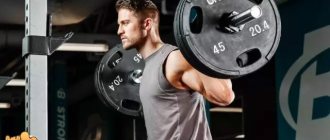Introduction
This article is a logical continuation of the first part about the difficult path of a beginner in the gym. In it we talked about what training program to start with and what to strive for. Well, now, as promised, let's move on to split training. And according to tradition, let’s explain what this means. This means that it will no longer be possible to train the entire body in a workout, but specific muscle groups. This will allow them to be given a varied load and increase stimulation of different muscle fibers within the same group.
What is the basis for building a split training program? Split means “division” in English. That's what we'll do. We will build weight gain for men based on the fact that we train six muscle groups (let me remind you: legs, back, chest, deltoids, arms, abs), and training takes place three times a week, we will divide them this way: we will train two muscle groups in day. Exercises for the abdominal muscles will continue to be present all the time.
The duration of the second stage will be 6 months. We will change the program every month, giving priority to basic exercises with the inclusion of additional exercises for a given muscle group. We will work mainly in the 10 repetition range. Training time is up to 1.5 hours, rest between moderate approaches is a minute/one and a half, rest between heavy approaches is 2 minutes, or until complete recovery, as discussed in previous articles. We still continue to do hyperextensions at the beginning of each workout, and perform abdominal exercises at the end of the workout. Also, we have deadlifts in our program. But before we begin, let's return to three old questions.
First , is the training program given here aimed at gaining muscle mass or total body mass? The program below is a workout program for gaining muscle mass for men. We have in our arsenal the skills of performing exercises developed during the first stage and the laid foundations for the formation of a neuromuscular connection. This is already a great help in the process of building muscles.
Secondly , can less experienced and more experienced athletes train in a split pattern? For a beginner, it would be highly recommended to train according to the “full body” principle; if you start training with a split scheme from scratch, then only under the guidance of a personal trainer. More experienced athletes not only can, but often use the split scheme as a fundamental principle for constructing training programs.
So. Stage two. Duration: 6 months. Goal: building muscles. Change of training cycle: every 4 weeks.
Recovery after training
Beginners are mistaken in believing that the key to muscle growth lies only in proper training. In fact, to create the body of your dreams, you will need to follow a routine and get enough rest. Remember - muscles do not grow in the gym, but in breaks between classes, during the recovery process.
The optimal number of workouts per week for gaining weight is 3; if the body does not have time to renew its strength, it can be reduced to 2. It is important to know that large muscle groups recover in approximately 72 hours, small ones – 48. But keep in mind that each person is individual.
The goal of training in the gym is to cause microtrauma to the muscles. That's why volumes only increase during rest - muscle fibers gradually heal, recover, become larger and stronger.
How to properly recover after training
Don't forget about your sleep schedule: proper training is good, but your sleep schedule is no less important. Therefore, you need to ensure that you get adequate sleep. Lack of sleep inhibits muscle growth.
Muscle gain program for men: 1st cycle
We will structure our training in the first month this way. First day: chest/shoulders. Day two: biceps/triceps. Day three: legs/back.
Comments. Day 1: hyperextensions will be written separately below. Bench press - on a horizontal bench, dumbbell press and flyes as well. Seated dumbbell press, rows to the chin and reverse flyes according to the technique. Day 2: straight barbell lifts, dumbbell lifts and standing hammers, according to technique. Push-ups will also be discussed separately. French bench press and overhead extension according to the technique. Day 3: squats with a barbell, leg extensions and lunges according to the technique. About pull-ups also at the end, bent-over barbell rows - with a straight grip, dumbbell rows to the belt according to the technique.
Muscle gain program for men: 2nd cycle
We will structure the second month of training in this way. First day: back/triceps. Day two: legs/shoulders. Day three: chest/biceps.
Comments. Day 1: Bent-over barbell row - reverse grip. The deadlift will be discussed below. Traction of a horizontal block according to the technique. Close grip press, French dumbbell press and arm extensions according to the technique. Day 2: squats - with a barbell on the chest. Romanian deadlifts and calf raises according to technique. We perform the standing barbell press from the chest. Bent-over dumbbell flyes and shrugs with dumbbells - according to the technique. Day 3: bench press - on a bench with an upward slope. Chest press in the simulator and butterfly according to the technique. Lifting the barbell in a Scott bench is performed with an EZ bar, lifting dumbbells in a Scott bench and concentrated lifting - according to the technique.
Muscle gain program for men: 3rd cycle
For the third month we will train as follows. First day: legs/biceps. Second day: chest/back. Day three: shoulders/triceps.
Comments. Day 1: perform standard squats. Leg press and leg curls according to technique. Lifting the barbell - with a straight bar, hammers according to the technique - while sitting, lifting in a block also according to the technique. Day 2: bench press - on a horizontal bench, dumbbell press as well, crossover exercises - from the upper blocks. We perform pull-ups and deadlifts according to the technique, T-bar rows in the station with emphasis on the chest. Day 3: Arnold press, standing dumbbell flyes and shrugs with dumbbells are performed according to the technique. Technique dips on parallel bars, seated French press with a barbell, bent over arm extensions with both hands at the same time.
Muscle gain program for men: 4th cycle
For the fourth month we will structure our workouts this way. First day: chest/triceps. Day two: back/shoulders. Day three: legs/biceps.
Comments. Day 1: perform the bench press on a bench with a downward slope, and do the dumbbell press as well. Butterfly in the simulator - according to the technique. Reverse push-ups from the bench - with weights, extension from behind the head and in an incline according to the technique. Day 2: bent over barbell row - with a straight grip, deadlift - according to the technique, vertical row - to the chest. Perform the seated barbell press behind the head. Bent-over raises and barbell rows to the chin - according to the technique. Day 3: squats - with a barbell on the chest. Romanian deadlifts and leg extensions - technique. Biceps curls on a Scott bench - EZ bar. Dumbbell curls for biceps and hammers - according to the technique.
Strength and mass training program
The training split lasts two weeks and combines training of different muscle fibers. You'll train both glycolytic muscle fibers by training in the five-rep range and oxidative fibers by training in the 6- to 12-rep range. Although in fact it is not the number of repetitions that matters, but the time under load . Thus, you perform five repetitions in about 15-20 seconds, and 6-12 repetitions in 30-50 seconds. Accordingly, if you perform 6 repetitions, then each repetition should take 5-7 seconds. It should be borne in mind that the negative phase should take longer than the positive one. For example, it takes longer to lower the barbell down than to press it up, well, lower it for 3 seconds and press it for 1-2. It is also important to note that in the last set you must reach positive failure, that is, the inability to perform at least one more repetition in the positive phase without additional help. But you should still be able to perform a negative repetition, which will indicate that you have loaded the muscle enough, but not too much.
In addition to the time under load, the rest time between sets is also different in strength and mass training. Oxidative fibers need to recover for about a minute, since their energy supply is provided not only by creatine phosphate, but also by glycolysis, and you generally train the ability to supply energy to these muscle cells precisely through glycogen. Glycolytic fibers consume a lot of energy, which is why they are so “strong”; as a result, the body needs creatine phosphate to provide them with energy. And in order to restore the supply of creatine phosphate, it takes 5-10 minutes, but since we are training not only strength indicators, but also mass, in this case you should rest for 5 minutes. Experienced exercisers can stretch their muscles during rest, but only if they know how to do this without overloading their joints. Before moving on directly to training, I would like to give a recommendation that will allow you to increase the effectiveness of this program. It wouldn't hurt to buy creatine, it's not absolutely necessary, but it wouldn't hurt.
Notes: Rest 5 minutes between sets on day 1 of the bench press, day 3 of the deadlift, day 7 of the squat, and day 9 of the bench press. On the ninth day, you will perform the pyramid up to one repetition, that is, you need to warm up and perform 5 repetitions in the first approach, but not to failure. In the second approach, 4 repetitions, increasing the weight and still not reaching failure, until the last approach, in which you must select such a weight that you reach failure in 1-2 repetitions. During all other exercises, rest for 40-60 seconds. There is one day of rest between workouts, and there is no rest before the last workout, but after it you need to rest for two days and then start the program over again.
Muscle gain program for men: 5th cycle
The fifth month will be designated as such a training split. First day: back/biceps. Day two: legs/triceps. Day three: chest/shoulders.
Comments. Day 1: pull-ups, deadlifts and horizontal block rows are performed according to the technique. Lifting the barbell for biceps - with a straight bar. Concentrated biceps curls and biceps curls in a block - according to the technique. Day 2: squats – standard. Hack squats and standing calf raises - according to the technique. Bench press with a narrow grip and French press - according to the technique. Reverse push-ups - with additional weights. Day 3: perform the bench press on a horizontal bench, and dumbbell flyes as well. Information in the crossover is from the lower blocks according to the technology. Seated dumbbell press, seated dumbbell flyes and reverse flyes - according to technique.
Iron Health
You can find many programs on the Internet for gaining muscle mass, but most of them are formulated incorrectly and do not provide the main factors for muscle growth. In today's article, I want to share with you my training program, which I wrote based on all the scientific data and research on the issue of gaining muscle mass that I have studied over a long time. This program is so effective and scientifically logical that I can call it one of the best programs for gaining muscle mass that I have ever used.
Basic principles of a proper mass program
Any training program aimed at increasing muscle mass must, firstly, take into account the main factors of muscle growth; secondly, it should not be too heavy; thirdly, it must provide a competent recovery regime.
To fulfill these conditions, my program will be based on the following principles:
- Training 3 times a week – we will train no more than 3 times a week – Monday, Wednesday, Friday. This training regimen will be optimal from a recovery point of view.
- Split circuit based on antagonist muscles - to increase the effectiveness of training, we will build split circuits by combining antagonist muscles: Monday - chest + back; Wednesday – quadriceps + hamstrings; Friday – biceps + triceps.
- 2 basic and 2 isolated exercises for each muscle - we will use a pair of basic and a pair of auxiliary isolated movements for each muscle group. Thus, the workout will include 8 exercises.
- Alternating exercises for different muscle groups – optimal training of antagonist muscles involves alternating exercises. That is, first we do the first exercise for one muscle group, then the first exercise for the second, and so on. This will significantly increase the intensity of the exercise.
- High intensity in basic exercises - to obtain the main stress load, we will perform basic exercises with a large working weight in the average repetition range - 6-8 times.
- High volume in isolated exercises – we will perform isolated exercises in a large number of repetitions (15), combining them into supersets. This will allow you to “acidify” the working muscles after strength training, as well as reduce the time of the workout itself.
Training program for gaining muscle mass
Next, we will introduce the program itself in question. Monday (pectoral muscles + back)
| Exercises | Approaches | Repetitions | Rest between sets |
| Bench press | 3 | 6 | 3 min |
| Pull-ups with weight | 3 | 6 | 3 min |
| Dumbbell Bench Press | 3 | 8 | 3 min |
| T-bar row | 3 | 8 | 3 min |
| Crossovers on the upper blocks in a superset. Overhead rows to the chest on the block. | 3 | 15 | 2-3 min |
| Superset dumbbell flyes Bent-over dumbbell rows | 3 | 15 | 2-3 min |
| Stretching working muscles | 2-3 min | ||
Wednesday (quadriceps + hamstrings)
| Exercises | Approaches | Repetitions | Rest between sets |
| Romanian deadlift | 3 | 6 | 3 min |
| Leg press | 3 | 6 | 3 min |
| Hyperextensions for hamstrings | 3 | 8 | 3 min |
| Lunges on a step platform | 3 | 8 | 3 min |
| Leg bending in the simulator in a superset Leg extension in the simulator | 3 | 15 | 2-3 min |
| Stretching working muscles | 2-3 min | ||
Friday (biceps + triceps)
| Exercises | Approaches | Repetitions | Rest between sets |
| Barbell curl | 3 | 6 | 3 min |
| Dips with weights | 3 | 6 | 3 min |
| “Hammer” standing | 3 | 8 | 3 min |
| Close grip bench press | 3 | 8 | 3 min |
| Lifting the barbell on a Scott bench in a superset. Extension of the arms from behind the head in the machine. | 3 | 15 | 2-3 min |
| Curling the arms on the lower block in a superset Pressing down on the upper block | 3 | 15 | 2-3 min |
| Stretching working muscles | 2-3 min | ||
The technique for performing the exercises presented in the program can be found on our website by using the search.
- The total duration of the complex is 6 weeks.
- During this program, monitor your diet and supplement intake - you should consume at least 2 grams of protein per 1 kg of your weight.
- Be sure to take creatine to keep your workout intensity high.
Muscle gain program for men: 6th cycle
We will be training in this split for the sixth month. First day: chest/legs. Day two: back/shoulders. Day three: triceps/biceps.
Comments. Day 1: bench press is performed on a bench with an upward inclination. Chest press in the simulator and butterfly exercises - according to the technique. Squats - with a barbell on the chest. Leg presses and lunges with a barbell according to the technique. Day 2: T-bar row in the machine with emphasis on the chest. Deadlift and dumbbell row to the belt - according to the technique. Standing barbell press - from the chest. Inclined flyes - according to the technique. We perform shrugs with a barbell behind our back. Day 3: dips and French dumbbell press while seated – based on technique. Arm extensions in a block - with a rope. Lifting the barbell in a Scott bench - with a straight bar. Lifting the barbell with a straight grip and hammers - according to the technique.
Notes
Hyperextension. Previously, during the two months of the first stage, we performed this exercise without weights. The lower back muscles have already become accustomed to such a load and most likely no longer react to it. This indicates that it is time to use additional weight in the exercise. The most convenient way for this purpose is a barbell disc, which you need to throw behind your head and hold on your shoulder blades.
Bars. Everything here is purely individual, but if you can do push-ups on the uneven bars more than 10 times, there is no point in doing it 15, 20, or more times, since you will be training endurance, and gaining weight for men involves slightly different manipulations. What to do? Take a belt, a chain, and do push-ups with weights, but as before - no more than 8-10 times. Where to begin? Hang a 2.5 kg disc on your belt. Still doing more than 10 times? Weigh 5 kg. Choose a weight for 8-10 reps.
Pull-ups. The same story as with dips. If you can do more than 10 pull-ups, hang a weight on your belt. Start the same way, for example with 2.5 kg. Adapt the weights according to the same principle - select the weight for the given number of repetitions. In this case, it is necessary to select the weight so that at the 8th, 9th repetition you already feel tired and tense, and the final repetition goes through strength.
Deadlift. As you noticed, in the first cycle it is absent, since we train our back on the same day as our legs and it is undesirable to perform two heavy basic exercises on the same day. Moreover, during the first cycle, using hyperextensions, you will sufficiently work the lumbar muscles, which are involved when performing deadlifts, without which, in turn, a training program for gaining muscle mass for a man would be incomplete.
How can a beginner gain 5-7 kg of muscle?
Do you dream of changing your body and pumping up your muscles so that instead of an angular figure, you see elastic muscles and sculpted abs in the mirror? The Beginner's Guide is intended for men aged 18-35 with a normal or thin build. We do not recommend this program for adolescents under 18 years of age, as the strength training suggested may negatively affect growth and overall development of the spine.
We also note that this program assumes minimal experience in strength training. If you come to the gym for the first time, a special training program in the gym will suit you. Before moving on to full strength training with a barbell, it is recommended to perform a simplified program on machines for 1-2 months.
In addition, the program is primarily designed to gain muscle mass - despite the fact that it can correct the shape of the body and get rid of a small tummy, the Beginner's Guide is not designed for those who need to get rid of a significant amount of subcutaneous fat. If you want to lose weight, read the material on how to deal with belly fat.
Introductory strength training course
When a beginner comes to the gym for the first time, he begins to repeat what most people around him do - endless exercises on the machines and intensive pumping of the arms. In this case, there is either no training program at all, or the classic scheme of three workouts per week is used (that is, “Monday – back, Wednesday – legs, Friday – chest”).
Unfortunately, this training regimen is not very effective for thin beginners who have problems gaining muscle mass. They need a basic mass training program consisting of just five complex barbell exercises that best affect the body's hormonal levels and metabolism.
Afterword
As for the number of approaches: while the weights are small, you can perform one warm-up approach before the working weight. A working weight is a weight with which you can perform a given number of repetitions. For example, if in the bench press program you must complete 3 sets of 8 repetitions, and for this number of repetitions you can press, say, 40 kg, then it will be enough to perform one warm-up set with a weight of 20 kg, and then three working sets with a weight of 40 kg. Warm-up sets do not count. When you reach a weight of, say, 80 kg, you can perform two warm-up approaches, the first with a weight of 40 kg, the second with a weight of 60 kg, and then proceed to working approaches. The warm-up rule applies to all exercises. We have already said that it is necessary to do a warm-up.
Globally, the approach to the training process described in this article is called the linear progression method. The weight training program for men, in the context of this method, provides for the fulfillment of the following basic conditions. The first is a constant increase in working weights (we have already talked about this). And the second, which follows from the first, is that every week is hard, that is, every next week you try to lift more weight than the previous one. This is the principle of linear progression.
MYTH. There is an opinion that some exercises can be split, while others cannot. The concept of weight training itself debunks this myth. The essence of the training is to create the maximum traumatic effect on the muscles, which will give them an incentive to heal and grow. It is the quality of the training that is important, not the split itself. For this reason, the definition of “correct split” or “incorrect split” is inherently completely untenable.
EXPERIENCE. You can often hear the question - why do several exercises for one muscle group? The answer is extremely simple. Each muscle group needs to be worked out comprehensively, putting a load on each of its sections (external, internal, lower, upper, peak), then you will get results. Whatever muscle group you work on, a prerequisite is to perform basic exercises, as well as diversify the load through different exercises for the target muscle group.
ADVICE. Most beginners who just join the gym either copy the training programs of famous athletes, or start training according to the same programs as their more experienced friends. Both cases, for obvious reasons, exclude the period of laying the foundation. This course of events is a significant omission, like an attempt to build a house not on a solid foundation, but on soft ground, which in the future will lead either to injuries, or to stagnation in training, or to a lack of desire and refusal to train. Don't neglect the foundation stage.
Training program for gaining weight
For anyone looking to gain large amounts of muscle mass, one of their top priorities should be figuring out the best training program. There are many different training programs available, so it is important to choose one that suits your needs.
It is also important to understand what factors contribute most to muscle growth, what exercises are most effective for gaining muscle mass, and a program based on these principles will be much more effective.
We have collected for you the best weight training programs that show amazing results with the right approach. Let's take a quick look at the most effective and popular strength training programs and identify the pros and cons of each.
Exercises
You can find a complete illustrated description of the exercises given in this program, the technique for performing them and tips by following the links to articles with the appropriate title: Exercises for the chest muscles Exercises for the back muscles Exercises for the leg muscles Exercises for the shoulder muscles Exercises for the biceps Exercises for triceps exercises for abdominal muscles
Diet for muscle growth
The main problem in gaining muscle for naturally thin ectomorphs is that their body does not know how to accumulate a sufficient amount of energy either for strength training or for the subsequent restoration and growth of muscle tissue. This is why diet is, in fact, more important than the training itself.
Most often, ectomorphs eat little and do not even meet the daily calorie requirement - or they do, but at the expense of the wrong foods, which cause a gain of belly fat. For muscle growth, the calorie intake must be 20% higher than normal, and the diet itself must be compiled taking into account a number of rules.
Nutrition rules for gaining weight
A sports diet is not just an increased intake of protein isolate or other supplements from the rating of the best sports supplements. In order for increased caloric intake to produce an increase in lean muscle mass without fat, you must carefully analyze your diet and follow three rules:
1 . Fats should account for 30-35% of calories . A smaller amount of fat will lead to a decrease in immunity and a drop in testosterone levels, a larger amount of fat will lead to excess weight gain. The types of fats also play a significant role - but more on that later.
2. Half as much protein as carbohydrates . The biggest fitness myth is that the more protein, the better for muscle growth. Real studies refute this, showing that the amount of protein in the diet should be about half as much as the amount of carbohydrates.
3. The basis for muscle growth is the right carbohydrates . About 40-45% of the calories in a sports diet for muscle growth should be carbohydrates with medium and low GI, and immediately after strength training, to close the carbohydrate window, it is recommended to take a cocktail of isolate protein and fast carbohydrates.
Mass training program: 1 week
Before you change your diet, it's important to understand what you're dealing with. Write down everything you eat during the day (weighing portions if possible), and then calculate the approximate calories and amount of protein, fat and carbohydrates. For a menu with recommendations for products for muscle growth and sports supplements, see the link.
***
The secret to rapid muscle growth is increased nutrition (subject to a number of rules) and rare, but difficult, strength training using multi-joint basic exercises. Everything else (sports nutrition, “advanced” training methods, and so on) plays a much less important role.











